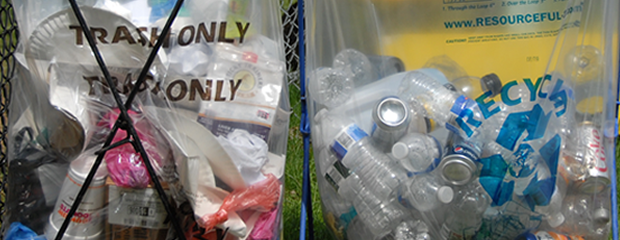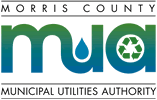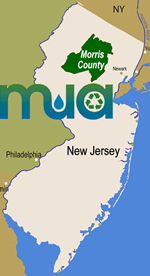Transfer Station Info (Tip Fee $111.25/ton)
- Mt. Olive Mon-Fri 7:30am-3pm; Sat 7:30am-11am
- Parsippany Mon-Fri 7am-3pm; Sat 7:30am-11am
- Closed Sundays and Major Holidays
- No Rental Trucks
- Payment by Account, Check, Credit Card. No Cash

Morris County
Municipal Utilties Authority
Transfer Station Info (Tip Fee $111.25/ton)
- Mt. Olive Mon-Fri 7:30am-3pm; Sat 7:30am-11am
- Parsippany Mon-Fri 7am-3pm; Sat 7:30am-11am
- Closed Sundays and Major Holidays
- No Rental Trucks
- Payment by Account, Check, Credit Card. No Cash
Source Separation Recycling

The passage of New Jersey’s mandatory recycling legislation in April, 1987 was a major milestone in New Jersey's solid waste management history and helped establish Morris County, New Jersey as an early recycling leader. The “New Jersey Statewide Mandatory Source Separation and Recycling Act”, N.J.S.A. 13:1E-99.11 et seq., set forth source separate and recycle requirements applicable to all New Jersey's residents, businesses and institutions for designated materials.
The Morris County Solid Waste Management Plan is compliant with the Recycling Act in that the Plan requires "source separation" to be the primary method of keeping recyclables separate from garbage for the following reasons:
- Source separation is mandated by law under the New Jersey Source Separation and Recycling Act (N.J.S.A. 13:1E-99 et. seq.). In support of this law, the MCMUA favors a consistent source separation policy throughout the residential, commercial and institutional sectors.
- Source separation promotes the removal of all designated recyclable materials from the waste stream and, therefore helps in achieving high reduction rates.
- Source separation results in clean, marketable materials by limiting levels of contamination. Contamination undermines long-term marketability of recyclable materials.
- Source separation enables the recycler at the source to receive the economic benefits of cost avoidance by not disposing of recyclable materials as garbage as well as enabling the recycler to receive revenue from the sale of the recyclable material.
- Source separation fosters a free market, independent of the solid waste (garbage) collection and disposal system. This reduces the need for burdensome regulations and costly enforcement.
- Proper documentation is difficult, if not impossible, when recyclables are mixed with garbage.
- Source separation fosters competition among recycling companies, thereby keeping costs low and quality of services high.
- Source separation encourages a thought process in each individual recycler that proper solid waste management is every person's responsibility. This can foster further source reduction and recycling activities at work, home and school.
This following list of mandated recyclable materials represents the minimum requirements for residents, businesses and institutions in Morris County. Individual municipalities may mandate additional materials in their municipal recycling ordinances.
-
Click here for a printable/distributable PDF version of this mandated to be source separated and recycled materials information.
1987-2012 - A Quarter Century of Mandated Recycling in NJ
In commemoration of the 25th anniversary of Governor Kean signing of New Jersey's mandatory source separation and recycling law, The EnviroPolitics blog wrote a story about New Jersey's two recycling pioneers; Jean Clark abd Mary Sheil. Click here to read to story that accompanies the two-part video interviews with these two recycling pioneers.
|
Materials Mandated to be Source Separated and Recycled |
|
|
Aluminum Cans |
Cans made from aluminum that were manufactured to hold a serving of a beverage. Specifically omitted from this definition are aluminum foil and aluminum pie plates. |
|
Glass Bottles and Jars |
Bottles and jars made from glass including clear, brown and green glass. A bottle is defined as a receptacle having a narrow neck and a mouth that can be corked or capped. A jar is defined as a wide-mouthed container that can be capped. Caps and lids not included. Specifically omitted from this definition are drinking glasses, windows, mirrors, light bulbs, and anything made of Pyrex® or ceramic. |
|
Plastic Bottles (coded 1 and 2)
|
Plastic bottles coded to indicate that they are comprised of the specific types of plastic compounds (polymers) known as polyethylene terephthalate (PETE) or high-density polyethylene (HDPE). See symbols to the left. A bottle is defined as a receptacle having a narrow neck and a mouth that can be corked or capped. Caps and lids not included. Any item made of plastic that is not a bottle, and any plastic bottle without one of the symbols shown to the left is specifically omitted from this definition. |
|
Steel (Tin) Cans |
An air-tight container for the distribution or storage of goods, composed of thin, usually ferrous, metal. Examples are soup cans and tuna fish cans. |
|
Newspaper |
A publication containing news, information and advertising, usually printed on low-cost paper called newsprint. Newspaper may include glossy inserts which come with the paper, dependent upon the market conditions at the time. |
|
Corrugated Cardboard |
Shipping containers made with kraft paper linerboard and corrugated medium. |
|
Mixed Paper |
Various categories of recyclable paper including, but not limited to white and colored paper used in printers, photocopiers and fax machines, white and colored ledger paper, carbonless copy paper, construction paper, undeliverable mail, mailed promotional letters/ advertisements/circulars, magazines, catalogues, envelopes, soft cover books. |
|
Leaves |
Vegetative material, typically generated in the autumn when they fall from trees and then are raked from residents' and/or commercial lawns. |
|
Grass Clippings |
Vegetative material generated when grass (lawns) are cut. |
|
Brush |
Branches, woody plants and other similar vegetative material. Leaves and grass do not constitute brush. |
|
Natural Wood Waste |
Logs, stumps, branches and other wood tree parts. Dimensional lumber is omitted from inclusion in this definition. |
|
Oil-Contaminated Soil |
Non-hazardous soil that contains petroleum hydrocarbons (gasoline, diesel, kerosene, jet fuel, #4 & #6 heating oils and certain other refinery products including coal tar). This type of soil shall be determined to be non-hazardous in accordance with the standards set forth in N.J.A.C. 7:26. |
|
Used Motor Oil |
Motor oil from motor vehicles, lawn mowers, boats, etc., which has served its intended useful purpose. |
|
Lead-Acid Batteries |
Storage batteries in which the electrodes are grids of lead containing lead oxides that change in composition during charging and discharging, and the electrolyte is dilute sulfuric acid. These include starting batteries such as car batteries that deliver a short burst of high power to start the engine. In addition, they may include deep cell batteries found on boats or campers used to power accessories like trolling motors, winches or lights. |
|
Hazardous Dry Cell Batteries |
Rechargeable batteries, such as nickel-cadmium, nickel-iron, nickel metal hydride, lithium ion, small sealed lead acid, etc. These are often used as substitutes for non-rechargeable batteries in standard sizes such as AAA, AA, C, D and 9V. Rechargeable batteries are commonly found in cordless tools, cellular and cordless phones, laptop computers, cameras, remote controls, toys, etc. Also included in this definition are non-rechargeable batteries that are hazardous as defined by the Resource Conservation Recovery Act ("RCRA"), regardless of the RCRA exclusion of household waste from the definition of hazardous waste pursuant to 40 C.F.R. 261.4(b). Non-rechargeable, hazardous batteries include older alkaline and carbon zinc batteries as well as silver oxide, mercury and magnesium button-type batteries, etc. It should be noted that domestically manufactured alkaline and carbon zinc non-rechargeable batteries made after circa 1994 eliminated mercury content to the point that they should not be considered RCRA hazardous and therefore are not included in this material category. Click here for more information about dry-cell battery management in Morris County. |
|
Metal Appliances |
Appliances composed predominantly of metal, and may include stoves, washing machines and dryers, for example, if the appliance is predominantly metal. Also included are air conditioners, refrigerators and dehumidifiers if they are predominantly metal. If these appliances on the latter list contain refrigerants that are prohibited by the Clean Air Act from being knowingly vented, the refrigerant must be recovered accordingly. |
|
Whole Tires* |
Tires that are whole, not chipped into small pieces. *Tires are allowed to be recycled and/or incinerated for energy recovery. |
|
Electronics - Televisions, Computers, Laptops, Monitors, Desktop Printers and Fax Machines |
As of 2011, televisions, computers, laptops and monitors are banned from the garbage in accordance with New Jersey’s Electronic Waste Management Act (Act). While not mandated to be recycled specifically by the Morris County Solid Waste Management Plan, these covered electronics are mandated to be recycled by default throughout New Jersey based on the Act. In 2018 desktop printers and fax machines were added to the list of electronic items banned from disposal and therefore required to be source separated and recycled. Click here for more information about recycling electronics in Morris County. |
The following section explains the changes made to each of the material categories, if any, since the 1993 Plan Amendment.
Newspaper - There is no change to the source separation requirement for Newspaper. This material remains mandatory for all generators to source separate and recycle.
Corrugated Cardboard - In the 1993 Plan Amendment, this material was referred to as "Corrugated." The term Corrugated Cardboard better explains type of material defined. There is no change to the source separation requirement for Corrugated Cardboard. It continues to be mandatory for all generators to source separate and recycle this material.
Mixed Paper - There is no change to the source separation requirement for Mixed Paper. It continues to be mandatory for all generators to source separate and recycle this material.
Aluminum Cans - In the 1993 Plan Amendment, this material was referred to as "Aluminum," and the intent was that it meant Aluminum Cans. The word "Cans" has been added to clarify the intent. Aluminum foil and aluminum pie plates are not included in this material. Otherwise, there is no change to the source separation requirement for Aluminum Cans. It continues to be mandatory for all generators to source separate and recycle this material.
Plastic Bottles coded 1 and 2 - In the 1993 Plan Amendment, this material was referred to as "Plastic Containers." It has since been learned that markets exist primarily for PETE (Polyethylene Terephthalate) and HDPE (High Density Polyethylene) plastic bottles (coded number 1 and number 2, respectively). See the symbols that follow. The word "Containers" has been replaced with the phrase "Bottles coded 1 and 2" to clarify that only bottles with the codes 1 and 2 as shown below are included in this material category, and other plastic bottles and containers are not. A bottle is defined as a receptacle having a narrow neck and a mouth that can be corked or capped. Otherwise, there is no change to the source separation requirement for Plastic Bottles coded 1 and 2. It continues to be mandatory for all generators to source separate and recycle this material.
Polyethylene Terephthalate: High Density Polyethylene:
High Density Polyethylene:
Glass Bottles and Jars - In the 1993 Plan Amendment, this material was referred to as "Glass Containers," and the intent was that meant Glass Bottles and Jars. The phrase "Bottles and Jars" has been added to clarify the intent. For example, drinking glasses and Pyrex® containers are not included in this material. Otherwise, there is no change to the source separation requirement for Glass Bottles and Jars. It continues to be mandatory for all generators to source separate and recycle this material.
Steel Cans - In the 1993 Plan Amendment, this material was referred to as "Ferrous Containers." It is now felt that a more recognizable term to describe this material is Steel Cans. Otherwise, there is no change to the source separation requirement for Steel Cans. It continues to be mandatory for all generators to source separate and recycle this material.
Leaves - In the 1993 Plan Amendment, this material was referred to as "Yard Waste." Leaves has been included as a separate item, in lieu of the broader term "Yard Waste," in order to differentiate between leaves and other organic material that is generated outdoors. Otherwise, there is no change to the source separation requirement for Leaves. It continues to be mandatory for all generators to source separate and recycle this material.
Grass - In the 1993 Plan Amendment, this material was referred to as "Yard Waste." Grass has been included as a separate item, in lieu of the broader term "Yard Waste," in order to differentiate between grass and other organic material that is generated outdoors. Otherwise, there is no change to the source separation requirement for Grass. It continues to be mandatory for all generators to source separate and recycle this material.
Brush - In the 1993 Plan Amendment, this material was referred to as "Yard Waste." Brush has been included as a separate item, in lieu of the broader term "Yard Waste," in order to differentiate between brush and other organic material that is generated outdoors. Otherwise, there is no change to the source separation requirement for Brush. It continues to be mandatory for all generators to source separate and recycle this material.
Lead-Acid Batteries - In the 1993 Plan Amendment, this material was referred to as "Vehicular Batteries." The term Lead-Acid Batteries better explains type of material defined. Otherwise, there is no change to the source separation requirement for Lead-Acid Batteries. It continues to be mandatory for all generators to source separate and recycle this material.
Metal Appliances - In the 1993 Plan Amendment, this material was referred to as "White Goods." It is now felt that a more recognizable term to describe this material is Metal Appliances. Otherwise, there is no change to the source separation requirement for Metal Appliances. It continues to be mandatory for all generators to source separate and recycle this material.
Used Motor Oil - In the 1993 Plan Amendment, this material was referred to as "Motor Oil." The term was changed slightly to Used Motor Oil to more clearly indicate that this is motor oil which has been used. Otherwise, there is no change to the source separation requirement for Used Motor Oil. It continues to be mandatory for all generators to source separate and recycle this material.
Oil Contaminated Soil – There is no change to the source separation requirement for Oil-Contaminated Soil. It continues to be mandatory for all generators to source separate and recycle this material.
Natural Wood Waste - In the 1993 Plan Amendment, this material was referred to as "Stumps," and the remarks indicated that the term Stumps included "logs, branches, natural wood waste." A more inclusive term to describe this material is Natural Wood Waste, which includes stumps logs and branches and other wood tree parts. Otherwise, there is no change to the source separation requirement for Natural Wood Waste. It continues to be mandatory for all generators to source separate and recycle this material.
Hazardous Dry Cell Batteries - In the 1993 Plan Amendment, this material was referred to as "Household Batteries." The term Hazardous Dry Cell Batteries better explains the material defined. This category has been modified slightly and now allows non-hazardous dry cell batteries to be disposed as MSW. Circa 1994, most non-rechargeable dry cell batteries became non-hazardous when the battery industry removed most of the mercury contained in the dry cell. If the industry continues to change the formulation of dry cell batteries, rechargeable and/or non-rechargeable, the determination of whether or not the battery must be source separated and recycled is based on whether or not it is hazardous.
Whole Tires - In the 1993 Plan Amendment, this material was referred to as "Tires." The category is now renamed Whole Tires to differentiate between whole tires and chipped tires. Chipped tires are excluded from this definition. Another change with this Plan Amendment regarding whole tires is that whole tires are allowed to be incinerated for energy recovery. Whole Tires are not acceptable at the transfer station for disposal because whole tires are not allowed for disposal at landfills, due to the fact that they tend to resurface after having been buried. Whole Tires are, however, allowed to be incinerated for energy recovery (waste-to-energy) or as a tire-derived fuel (TDF). Waste-to-energy is considered by the NJDEP to a "beneficial use." The category "beneficial use" is a separate and distinct waste handling method from recycling and is therefore not considered to be recycling. Therefore, Whole Tires are an exception on this list of designated materials in that all of the materials on this list must be recycled. Whole Tires must either be recycled or incinerated for energy recovery as a beneficial use.



